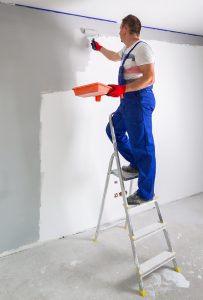Paint a Room
How to Paint a Room?
 While there are a variety of rooms in any house, the way each room is decorated is not particularly different, sometimes it is just the type of paint used that changes. You can also look at our Paint a Door, Painting Windows, and Paint a Staircase DIY guides. Or study these general painting tips.
While there are a variety of rooms in any house, the way each room is decorated is not particularly different, sometimes it is just the type of paint used that changes. You can also look at our Paint a Door, Painting Windows, and Paint a Staircase DIY guides. Or study these general painting tips.
Brand New Room, in Order:
The following is a bullet point guide on how to paint both brand new and previously painted rooms.
- Loosen all switch and socket plates, then tape around them with masking tape to avoid getting paint on them
- Sand down all the walls and ceilings
- Apply a 'mist coat' of 70% emulsion paint and 30% water to walls and ceilings to seal the plaster or plasterboard
- If any of the woodwork has knots in it, coat them with two coats of 'patent knotting'
- Remove all doors and remove all hinges and handles from them
- Prime any bare wood with one coat of primer (door edges, skirting boards etc.)
- Fill in any nail holes in skirting boards and door frames with a lightweight filler
- Fill any areas of uneven or damaged plaster on the walls and ceiling
- Sand down all the filler once dry and primed woodwork to remove any rough timber or dirt
- Vacuum the room and wooden surfaces to remove all dust
- Using decorators' caulk and a caulking gun, fill in all gaps between woodwork and plaster or plasterboard – smooth caulk off with a wet finger to provide a complete and smooth finish
- Apply two coats of emulsion paint to ceiling
- Apply two coats emulsion paint to walls
- Apply one coat of undercoat to all woodwork
- Lightly sand down all woodwork
- Apply two top coats of satinwood or gloss paint to all woodwork
- Remove masking tape from all switch and socket plates and tighten screws
- Rehang doors and reattach handles
- Give room a final vacuum
If painting windows, remove all catches and paint early in the day, refitting catches at the end of each day – however if possible close but not tight to save paint binding on window and frame.
Already Painted Room, in Order:
- Remove or move all furniture into centre of room and cover with dust sheets
- Cover all flooring with dust sheets
- Loosen all switch and socket plates and cover with masking tape to protect against paint
- Fill any cracks and damage to walls, door frames and skirting boards
- Sand down all walls and ceilings
- Sand down all pre-painted woodwork
- Vacuum the room thoroughly
- Remove all doors and then remove all hinges and handles from them
- Remove any paint on hinges and catchplates with paint stripper – wear protective gloves
- With decorators' caulk and a caulking gun, fill in any areas where woodwork has come away from plaster – smooth caulk off with a wet finger for a smooth finish
- Apply two coats of emulsion paint to ceiling
- Apply two coats of emulsion paint to walls
- Apply undercoat to all woodwork
- Lightly sand woodwork and apply two topcoats of satinwood or gloss
- Remove all masking tape from switch and socket plates and tighten up screws
- Rehang doors and attach handles and catchplates
- Remove all dustsheets, vacuum room and replace furniture
If painting windows, remove all catches and paint early in the day, refitting catches at the end of each day – however if possible close but not tight to save paint binding on window and frame.